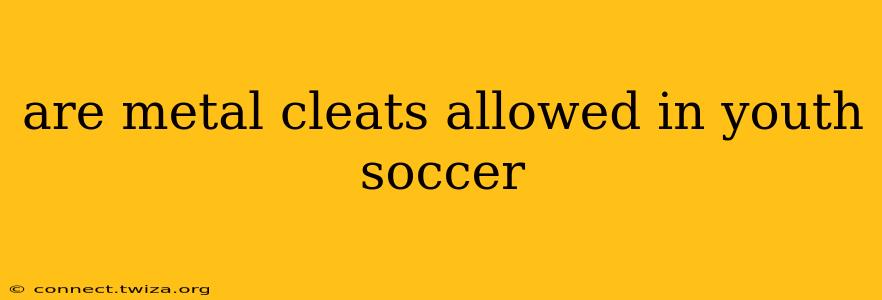Are Metal Cleats Allowed in Youth Soccer? A Comprehensive Guide for Parents and Coaches
The question of whether metal cleats are allowed in youth soccer is a common one, sparking debate among parents, coaches, and young players alike. The short answer is often no, but the specifics depend heavily on the governing body (like your local league, state association, or national federation), the age group, and the specific rules of the competition. Let's delve deeper into this crucial aspect of youth soccer safety and regulations.
What are the concerns about metal cleats in youth soccer?
Metal cleats, while offering potentially superior grip, pose significant safety risks, particularly for young players. The sharp edges can cause:
- Serious injuries to other players: A stray kick or accidental collision can lead to deep cuts, lacerations, and even broken bones for opposing players.
- Increased risk of injury to the wearer: The rigid nature of metal cleats can increase the likelihood of ankle sprains or other lower leg injuries. The increased traction can also contribute to over-stressing joints.
- Unfair advantage: Some argue that metal cleats provide an unfair advantage in terms of traction and speed, potentially leading to imbalances in the game.
What do the rules generally say about cleat types?
Most youth soccer leagues and organizations prohibit metal cleats, specifically for younger age groups. The reasoning centers on safety and the potential for injuries. While regulations vary, you'll often find that:
- Younger players (typically under 12 or 14): Often completely banned from wearing metal cleats. Soft-ground cleats with molded or plastic studs are generally preferred.
- Older players: May be allowed to use metal cleats under strict guidelines and with parental consent. However, many leagues still prefer plastic or molded studs even at older age levels to minimize the risk of injury.
Where can I find the specific rules for my child's league?
This is the most crucial step. Don't rely solely on general information. Always consult:
- Your league's official rulebook: This document should explicitly state the regulations regarding cleat types.
- Your child's coach: Coaches are typically well-versed in league-specific rules and can offer guidance.
- Your league's administrator or website: They can provide clarification on any ambiguities.
What types of cleats are recommended for youth soccer?
For youth soccer players, the safest and most commonly recommended cleats are those with:
- Molded studs: These are typically made of plastic or rubber and provide sufficient grip without the sharp edges of metal.
- Soft-ground cleats (SG): These cleats have longer studs, making them ideal for softer surfaces. They're usually made from plastic. Avoid metal SG cleats.
Are there exceptions to the rules about metal cleats?
While rare, exceptions might exist in very specific circumstances. For example, a highly competitive league with older players might permit metal cleats, but this would be clearly stated in their rules. Again, always check your specific league's regulations.
What happens if a player wears metal cleats when they are prohibited?
Consequences vary. A player wearing prohibited cleats might be:
- Asked to change cleats before participating: The most common outcome.
- Given a warning: A first offense might result in a warning.
- Suspended from play: Repeated offenses or flagrant disregard for rules could lead to suspension.
In conclusion, while some older youth leagues might allow metal cleats under certain conditions, the vast majority prohibit them for younger players due to safety concerns. Always check your specific league's rulebook and regulations before allowing your child to wear metal cleats. Prioritizing safety should always be the paramount concern in youth sports.
